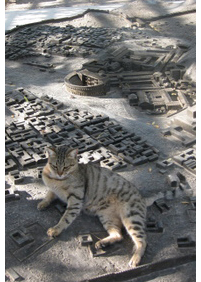SEARCH
 I don’t know if Ms. Whiskers the cat would have been recognized as a conquering force back in ancient times, but nonetheless the picture on the right shows a model of the ancient city Bet She’an. Were you to be standing in front of the model and turn 180 degrees you would see the remains of this glorious city that dates back some five thousand years and was home to several great empires including the Greeks and Romans It was during that particular period that the city was known as Scythopolis, and was one of ten major cities in the region.
I don’t know if Ms. Whiskers the cat would have been recognized as a conquering force back in ancient times, but nonetheless the picture on the right shows a model of the ancient city Bet She’an. Were you to be standing in front of the model and turn 180 degrees you would see the remains of this glorious city that dates back some five thousand years and was home to several great empires including the Greeks and Romans It was during that particular period that the city was known as Scythopolis, and was one of ten major cities in the region.
 son Jonathan were hung from the walls of the city (see the second book of Samuel, 1:17-27 for King David’s lament over the incident).
The city, which fell in the eighth century after a massive earthquake hit the region, was home to about 15-thousand people and featured an amphitheatre, bathhouses, fountains, shops, and at different periods included a temple, a synagogue, a mosque, and a Byzantine Church. The most striking sight for me though was high atop the hill where there was an Egyptian administrator’s house, dating back to 12th century BC!
This one location had a real and tangible record of thousands of years of history – of nations, of empires, of people…and it wasn’t in a stuffy museum, it was out in the open, in the actual location where people long ago would have bargained with merchants, had the dust scrubbed off them in bathhouses, taken in a tragedy on stage, and on and on.
As I sat on some rocks – or ruins, as they’re literally everywhere -- I imagined all these things happening in this thriving and bustling city… and now, it’s all history.
son Jonathan were hung from the walls of the city (see the second book of Samuel, 1:17-27 for King David’s lament over the incident).
The city, which fell in the eighth century after a massive earthquake hit the region, was home to about 15-thousand people and featured an amphitheatre, bathhouses, fountains, shops, and at different periods included a temple, a synagogue, a mosque, and a Byzantine Church. The most striking sight for me though was high atop the hill where there was an Egyptian administrator’s house, dating back to 12th century BC!
This one location had a real and tangible record of thousands of years of history – of nations, of empires, of people…and it wasn’t in a stuffy museum, it was out in the open, in the actual location where people long ago would have bargained with merchants, had the dust scrubbed off them in bathhouses, taken in a tragedy on stage, and on and on.
As I sat on some rocks – or ruins, as they’re literally everywhere -- I imagined all these things happening in this thriving and bustling city… and now, it’s all history.